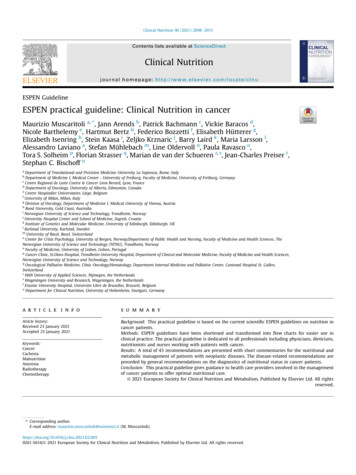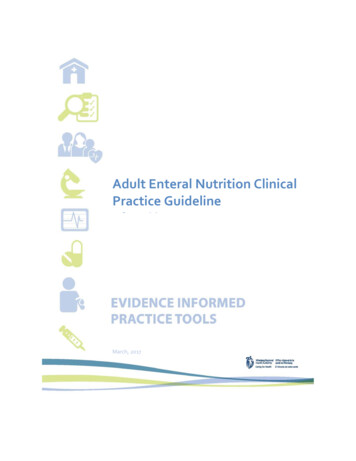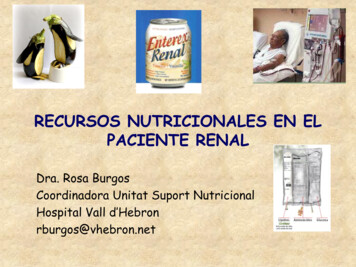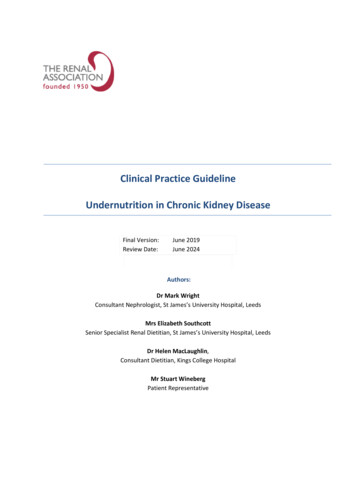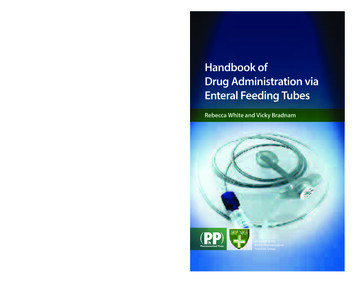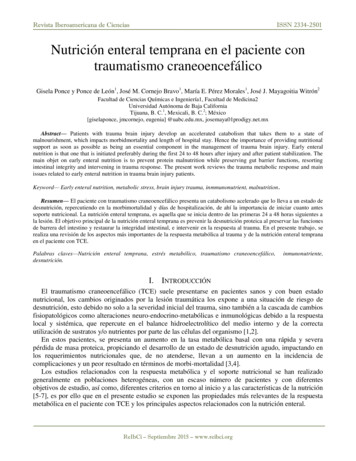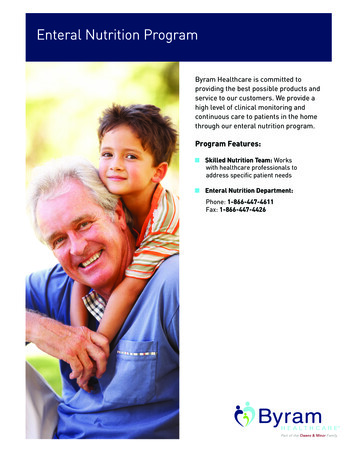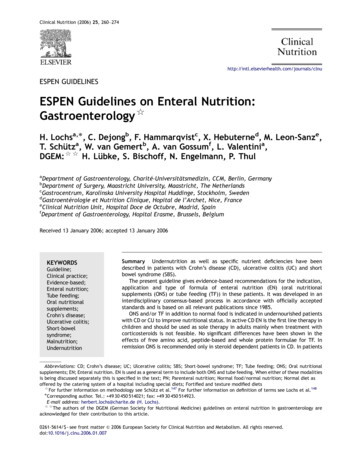
Transcription
ARTICLE IN PRESSClinical Nutrition (2006) 25, lnuESPEN GUIDELINESESPEN Guidelines on Enteral Nutrition:Gastroenterology H. Lochsa, , C. Dejongb, F. Hammarqvistc, X. Hebuterned, M. Leon-Sanze,T. Schütza, W. van Gemertb, A. van Gossumf, L. Valentinia,DGEM: H. Lübke, S. Bischoff, N. Engelmann, P. ThulaDepartment of Gastroenterology, Charité-Universitätsmedizin, CCM, Berlin, GermanyDepartment of Surgery, Maastricht University, Maastricht, The NetherlandscGastrocentrum, Karolinska University Hospital Huddinge, Stockholm, SwedendGastroentérologie et Nutrition Clinique, Hopital de l’Archet, Nice, FranceeClinical Nutrition Unit, Hospital Doce de Octubre, Madrid, SpainfDepartment of Gastroenterology, Hopital Erasme, Brussels, BelgiumbReceived 13 January 2006; accepted 13 January 2006KEYWORDSGuideline;Clinical practice;Evidence-based;Enteral nutrition;Tube feeding;Oral nutritionalsupplements;Crohn0 s disease;Ulcerative itionSummary Undernutrition as well as specific nutrient deficiencies have beendescribed in patients with Crohn’s disease (CD), ulcerative colitis (UC) and shortbowel syndrome (SBS).The present guideline gives evidence-based recommendations for the indication,application and type of formula of enteral nutrition (EN) (oral nutritionalsupplements (ONS) or tube feeding (TF)) in these patients. It was developed in aninterdisciplinary consensus-based process in accordance with officially acceptedstandards and is based on all relevant publications since 1985.ONS and/or TF in addition to normal food is indicated in undernourished patientswith CD or CU to improve nutritional status. In active CD EN is the first line therapy inchildren and should be used as sole therapy in adults mainly when treatment withcorticosteroids is not feasible. No significant differences have been shown in theeffects of free amino acid, peptide-based and whole protein formulae for TF. Inremission ONS is recommended only in steroid dependent patients in CD. In patientsAbbreviations: CD; Crohn’s disease; UC; Ulcerative colitis; SBS; Short-bowel syndrome; TF; Tube feeding; ONS; Oral nutritionalsupplements; EN; Enteral nutrition. EN is used as a general term to include both ONS and tube feeding. When either of these modalitiesis being discussed separately this is specified in the text; PN; Parenteral nutrition; Normal food/normal nutrition; Normal diet asoffered by the catering system of a hospital including special diets; Fortified and texture modified diets For further information on methodology see Schütz et al.147 For further information on definition of terms see Lochs et al.148 Corresponding author. Tel.: 49 30 450 514021; fax: 49 30 450 514923.E-mail address: herbert.lochs@charite.de (H. Lochs). The authors of the DGEM (German Society for Nutritional Medicine) guidelines on enteral nutrition in gastroenterology areacknowledged for their contribution to this article.0261-5614/ - see front matter & 2006 European Society for Clinical Nutrition and Metabolism. All rights reserved.doi:10.1016/j.clnu.2006.01.007
ARTICLE IN PRESSESPEN Guidelines on Enteral Nutrition261with SBS TF should be introduced in the adaptation phase and should be changedwith progressing adaptation to ONS in addition to normal food.The full version of this article is available at www.espen.org.& 2006 European Society for Clinical Nutrition and Metabolism. All rights reserved.Summary of statements: Crohn’s s for enteral nutrition are: prevention andtreatment of undernutrition, improvement ofgrowth and development in children andadolescents, improvements in quality of life, acutephase therapy, peri-operative nutrition,maintenance of remission in chronic active disease.Active diseaseMaintenance Grade147Number3In adults use enteral nutrition as sole therapy for theacute phase mainly when treatment withcorticosteroids is not feasible.Use combined therapy (enteral nutrition and drugs)in undernourished patients as well as in patientswith inflammatory stenosis of the intestine.In children with CD enteral nutrition is considered asthe first line therapy.A3.4C3.4C3.6In case of persistent intestinal inflammation (e.g.steroid dependent patients) use oral nutritionalsupplements.In longstanding (41 year) clinical remission and inthe absence of nutritional deficits a benefit ofenteral nutrition (oral nutritional supplements ortube feeding) or supplements (vitamins and traceelements) has not been demonstrated.B3.6B3.6Use peri-operative nutrition in CD patients withweight loss prior to surgery and low albumin.C3.5Use tube feeding and/or oral nutritionalsupplements in addition to normal food to improvenutritional status and to eliminate consequences ofundernutrition such as growth retardation.Correct specific deficits (trace elements, vitamins)by supplementation.Use continuous tube feeding rather than bolusdelivery because of the lower complication rate.A3.1/3.2C3.1/3.2B4.2Using oral nutritional supplements, a supplementaryintake of up to 600 kcal/day can be achieved inaddition to normal food.Use tube feeding if a higher intake is necessary.Tube feeding can be safely delivered by nasogastrictube or percutaneous endoscopic gastrostomy.A4.1CB4.14.2
ARTICLE IN PRESS262H. Lochs et al.Type of formulaActive diseaseThere are no significant differences in the effect offree amino acid, peptide-based and whole proteinformulae for tube feeding.Free amino acid or peptide-based formulae are notgenerally recommended.Modified enteral formulae (fat modified, omega-3fatty acids, glutamine, TGF-b-enriched) are notrecommended because no clear benefits have mberInitiate nutritional support in patients withundernutrition or inadequate nutritional intake.An influence of nutritional measures (nutritionalcounselling, oral nutritional supplements, tubefeeding or parenteral nutrition) on the inflammatoryactivity in acute or in chronically active ulcerativecolitis has not been demonstrated. Therefore,enteral nutrition is not recommended as treatmentof active ulcerative colitis.Enteral nutrition is not recommended.C9C10C11ApplicationTreat specific deficiencies with supplements.C9Type of formulaThe value of specific substrates (omega-3 fattyacids, glutamine, butyrate) on disease activity iscontroversial and not proven.UndernutritionEnteral nutrition may improve the quality of life inundernourished CD patients.Grade: Grade of recommendation; Number: refers to statement number within the text.Summary of statements: Ulcerative colitisSubjectIndicationsUndernutritionActive diseaseMaintenance ofremission10Grade: Grade of recommendation; Number: refers to statement number within the text.Summary of statements: Short-bowel e and/or improvement of nutritionalstatus, improvement of residual bowel function(adaptation), reduction of diarrhoea, improvementin quality of life.Grade147Number15RoutePostop. hypersecretion phaseParenteral nutrition is obligatory in order toguarantee adequate nutritional intake and fluid andelectrolyte replacement.C17.1Adaptation phaseUse continuous tube feeding-in limited amountsdepending on the enteral fluid loss to improveintestinal adaptation.C17.2
ARTICLE IN PRESSESPEN Guidelines on Enteral NutritionMaintenance/stabilisationphaseType of formula263With progressive adaptation provide enteralnutrition (even over night to increase time forabsorption) as a supplement to normal food.Use oral nutritional supplements or tube feeding ifnormal nutritional status cannot be maintained bynormal food alone.C17.2C17.3No specific substrate composition is required per se.Depending on the extent of malabsorption asignificant increase in energy and a modification ofsubstrate intake may be necessary.A regime to accelerate intestinal adaptation withrecombinant growth hormone, glutamine andspecial formula (low fat, high carbohydrates) is notgenerally recommended due to inconclusive results.C16C18Grade: Grade of recommendation; Number: refers to statement number within the text.Crohn’s disease (CD)1. What influence does CD exert onnutritional status and on energy andsubstrate metabolism?1.1. Acute phaseUndernutrition with weight loss, protein deficiency and specific deficiencies in vitamins,minerals and trace elements are common in theacute phase of CD.Anorexia, increased intestinal losses and systemic inflammation are the main causes ofundernutrition.In children and adolescents a decrease in growthvelocity may occur, secondary to inadequatenutrition and steroid therapy. The relevance andextent of these deficiencies vary according tothe site and extent of diseased intestine as wellas disease activity.Active CD causes the same non-specific alterations of substrate metabolism as are observed instarvation and/or inflammation. As these reflectinflammatory activity, they are therefore reversible by treatment.Comments: Weight loss is observed in up to 75% ofhospitalised adult patients with active CD.1–8 Anegative nitrogen balance caused by reducedintake, increased intestinal losses, and steroidinduced catabolism occurs in more than 50% ofpatients with active CD. Total body potassium maybe decreased.9Depending on the severity of diarrhoea, lowserum concentrations of potassium,10 magne-sium,11,12 calcium13 and phosphate14 havebeen described. A deficit in fat soluble vitaminscorrelates with the extent of steatorrhoea.Lower plasma concentrations of retinol, seen inactive CD, usually remain subclinical andare normalised after drug treatment, withoutthe need for supplementation. Low concentrationsof 25(OH)-vitamin D are found in more thanhalf the patients; however, only 45% of CDpatients develop osteopenia or osteomalacia inthe course of the disease.15 Decreased levels ofvitamin K are associated with reduced bone mineraldensity.16Vitamin E levels correlate with both total bloodcholesterol and total blood lipid concentration.Regarding water-soluble vitamins, lower serumconcentrations and deficits of vitamin B12 are welldocumented,1,7,17,18 depending on the involvementor resection of the terminal ileum. Measurement ofserum concentrations of ascorbic acid, nicotinicacid and biotin are not useful for estimatinginadequate supply.Resting energy expenditure may vary dependingon inflammatory activity,19 but total energy expenditure is similar to healthy subjects.20 It isslightly increased only if calculated in relation tofat-free mass (FFM).21 An intake of 25–30 kcal/kg BW/day is usually adequate to meet requirements.Changes in substrate metabolism, with reducedoxidation of carbohydrates and increased oxidationof lipids,9,22 are similar to the alterations instarvation and are not disease-specific. They arereversible when patients receive adequate nutritional support.In children and adolescents with CD, growthretardation has been described in up to 40% and a
ARTICLE IN PRESS264decrease in muscle mass and body fat in up to60%.23–25In nearly 90% of adolescent patients a decrease inheight and/or growth velocity below the 3rdpercentile is seen even before the diagnosis ismade, and often prior to other symptoms ofCD.26,27Growth retardation persists in 20–40% of patientsand final body height is below the 5th percentile in7–30% of patients.28–33 Nutritional treatment mayrestore growth velocity, after a period of retardation, but ultimate height still falls short of geneticpotential.32,331.2. RemissionMost patients in remission have an apparentlynormal nutritional status. Undernutrition, ifpresent, is mainly due to malabsorption resulting from previous surgery, with bile acid-induceddiarrhoea, or even from the development of SBS,bacterial overgrowth, or drug treatment (vitamin B12 malabsorption after treatment withsulphasalazine). Specific deficits (calcium, vitamin D and vitamin B12 deficiencies) requirespecial attention.Comments: In remission, deficiencies of macronutrients are rare. A deficit of vitamins and traceelements is only observed in a few individualcases.34There are conflicting results regarding nutritionalstatus of patients in remission. For example,body mass index (BMI) varies from similar35 tosignificantly decreased in CD-patients comparedwith healthy controls.36,37 In CD patients, reducedbody weight was found to be related to reducedbody fat mass (FM), whereas FFM was maintained.12,36 Alterations of substrate metabolismare still present in quiescent disease. As a resultof a higher lipid oxidation rate, the non-proteinrespiratory quotient has been shown to be significantly lower compared with healthy controls.38,39 The intake of energy and nutrients issufficient37 and comparable with that of a healthypopulation.12In untreated patients, osteopenia caused bynutritional deficits (protein, vitamin D and calcium)and by inflammatory cytokines may develop as thedisease progresses. In treated patients in remission,osteopenia is often an adverse effect of steroidmedication.38,40–44 An increased risk for fractureshas been described in CD patients45–48 and supplementation with calcium and vitamin D has beenrecommended in all patients on steroid treatment.49 Standard dosing as recommended forH. Lochs et al.osteoporosis with cholecalciferol 800–1000 IE/dayand 1000 mg/day ionic calcium should be used.Although higher doses might be necessary due tomalabsorption.2. What influence does nutritional statusexert on outcome?Undernutrition has a negative impact on theclinical course, the rate of postoperative complications and mortality (III).Comments: Mortality in CD is associated withvolume deficits, protein-calorie undernutritionand derangements of water and electrolyte balance.50 Preoperative undernutrition increases thelikelihood of postoperative complications51 andprolongs the length of hospital stay.523. What are the goals of enteral nutrition(EN) therapy?As in other diseases, the primary goals are Prevention and treatment of undernutrition(3.1.). Improvement of growth and development inchildren and adolescents (3.2.). Improvements in quality of life (3.3.).In addition there are specific indications for EN inCD Acute phase therapy (3.4.). Peri-operative nutrition (3.5.). Maintenance of remission (3.6.).3.1. Treatment of undernutrition3.2. Improvement of growthUndernutrition as well as growth failure cannotbe treated with nutritional counselling alone. TFand/or ONS, in addition to the normal food,improves nutritional status and eliminates theconsequences of undernutrition such as growthretardation, and is therefore indicated (A).Specific deficits (trace elements, vitamins) canbe corrected by supplementation (C).Comments: Several studies have demonstratedthat an improvement in nutritional status cannotbe achieved by nutritional counselling alone30,53(Ib). In adults as well as in children, supplementaryONS or TF improves nutritional status30,53,54 (Ib).
ARTICLE IN PRESSESPEN Guidelines on Enteral NutritionPatients with growth retardation defined as height/growth o3rd percentile or o4 cm/year for morethan two or more years, as well as retardedbone age, 4–6 week periods of EN providing upto 1000 kcal/day and/or overnight TF, in additionto normal food, can stimulate growth30 (Ib).Repeated treatments are useful. Intensifiednutritional therapy has to be initiated beforethe epiphysial growth plate is completed ifgrowth velocity is to be regained. Enterallyfed patients show a significantly higher increasein growth and FFM compared with those receivingsteroid therapy55 (III). Without TF, 50% ofgrowth retarded patients cannot regain their bodyweight with medical therapy alone: 28% of patientsremain growth retarded after 40 months despiteconventional drug treatment (5-ASA, steroids) andnutritional counselling56 (III).EN increases FFM and other body compartments(intra- and extracelluIar water) in children with CD.553.3. Improvement in quality of lifeEN may improve the quality of life in undernourished patients with CD (C)Comment: Improvement of nutritional status oftenleads to an improvement in general well-being.Whereas the negative effects of corticosteroids andthe positive effects of immunosuppressants on thequality of life in CD patients have been welldocumented76,77 (Ib), there are no systematic trialsof EN in this context.For treatment of short-bowel syndrome (SBS),see the end of this chapter.3.4. Primary therapy for active CDEN (ONS and TF) is effective in the treatment ofthe acute phase of the disease. In adults,however, treatment with corticosteroids is moreeffective (Ia): therefore, in adults, EN as soletherapy for acute CD is indicated mainly whentreatment with corticosteroids is not feasible,e.g. due to intolerance or refusal (A). Combinedtherapy (EN and drugs) is indicated in undernourished patients as well as in those withinflammatory stenosis of the intestine (C).In children with CD, EN is considered the firstline therapy (C)Comment: Several studies have shown the effectiveness of EN in the treatment of active phases ofCD. Approximately 60% of all patients reachremission57–67 (Ia). A recent Cochrane Review60(Ia) analysed four trials including 130 patientswith active CD treated with EN and 123 withcorticosteroids and confirmed the findings of earlier265meta-analyses that corticoid therapy in adultsis more effective than EN in inducing remission.Response rates to EN (intention to treat basis)vary between 53–80% after 3–6 weeks of therapy.The localisation of CD has no prognostic value forthe response to EN. The supposedly impairedresponse in Crohn0 s colitis has not been confirmed.58,65,66EN as primary treatment has a favourable impacton inflammatory processes, induces remission,treats undernutrition and its consequences, andavoids the side effects of conventional immunemodulating and suppressing agents (5-ASA, steroids, azathioprine, 6-mercaptopurine).The mechanisms of the above favourable effectsof EN on inflammation in CD remain unclear: thehypotheses of bowel rest, improved nutrition or areduced intestinal antigen load have not beenproven. A reduction of intestinal permeability isassumed.Total parenteral nutrition (PN) is no better thanEN in the therapy of active CD and should thereforebe restricted to patients with a contraindication toor intolerance of EN (Ib).68–71Compliance of patients receiving ONS, especiallywith peptide-based formulae, is low.65 More than20% of randomized patients receiving ONS withpeptide-based or whole protein formulae stop thetreatment due to the unpalatability of the enteralformula or intolerance.58 Withdrawal rate is significantly lower with nasogastric tubes (8%) thanwith oral intake (34%).67With the tendency to high relapse rate inchildren, it is essential to optimise nutritionaltherapy to promote growth. The use of EN inchildren and adolescents with CD has the potentialto reduce the need for corticosteroid treatment,and may have a prompt effect in reducingabdominal pain due to strictures.59 EN, therefore,is commonly used as initial therapy in children withactive CD.3.5. Peri-operative nutritionPostoperative complications are increased in CDpatients with weight loss prior to surgery andlow albumin (IIa). Peri-operative nutrition istherefore recommended in this patient group (C).Comment: An increased frequency of postoperative complications has been shown in CD patientswith severe nutritional risk,51 being defined asweight loss410% within the last 3–6 months,BMIo18.5 kg/m2 and/or plasma albumin levelsbelow 30 g/l. Although specific data concerningthe effect of peri-operative nutrition in CD arelacking, there is a considerable body of evidence
ARTICLE IN PRESS266about the effect of peri-operative nutrition ingeneral gastrointestinal surgery and in criticallyill patients. Patients with CD should thereforebe treated accordingly. Recommendations concerning peri-operative nutrition are outlined in thechapter ‘‘Surgery including Organ Transplantation’’(p. 224).3.6. Maintenance of remissionThe length of remission and subsequent relapserate after remission induced by EN are comparable to that after treatment with corticosteroids in children and adults. (Ib). In the case ofpersistent intestinal inflammation (e.g. steroiddependent patients) ONS have been shown to bebeneficial (B).In longstanding (more than 1 year) clinicalremission and in the absence of nutritionaldeficits, a benefit of EN (ONS or TF) or supplements (vitamins and trace elements) has notbeen demonstrated (B).Comment: One-year relapse rates have beenreported to be 25–42% after successful treatmentof active CD by EN and 17–67% after steroid therapy(Ib).29,64 One trial reported that the achievementof positive nitrogen balance during EN was followedby clinically sustained remission (III).72If supplementary EN is continued after the activephase, it prolongs the relapse-free interval(IIa).73–75 The localisation of CD has no impact onthe chances of relapse.In disease causing fistulae or strictures, relapseoccurs early if long-term EN is discontinued. Inchildren and adolescents, ONS can improve growthand prolong remission in some situations74 (III),(Ib).54 Remission may be prolonged in adults.4. Practical implementation of EN4.1. Which patients should receive ONS? When isTF indicated?With ONS, a supplementary intake of up to600 kcal/day can be achieved in addition tonormal food (A).If a higher intake is required, TF is necessary (C).Comment: In a controlled cross-over study, anincrease in the daily intake of 600 kcal has beenachieved, using ONS, in patients with inactive CD(Ib).54A higher intake is feasible for short periods in thetreatment of active CD65 (Ib); but it appears not toH. Lochs et al.be tolerated over a long period. Most cases withgrowth retardation, therefore, require TF.4.2. Are there special issues concerning themethod of delivery or the formulae for EN in CDpatients?TF can be safely delivered by a nasogastric tube(NGT) or percutaneous endoscopic gastrostomy(PEG) (B).Continuous administration of TF rather thanbolus delivery is preferred because of the lowercomplication rate (B).Comment: Continuous administration is associatedwith fewer complications than bolus delivery.78 Inchildren with growth retardation, overnight TF hasbeen used successfully. Children learn quickly topass feeding tubes every evening and are notinhibited in their daily life (Ib).53,55If a NGT is not accepted or the duration offeeding required is anticipated to be more than 1month, a PEG may be placed for long-termnutrition. This method is safe in CD, has noincreased rate of complications, and does notresult in persistent gastric or entercutaneousfistulae79 (III), (IIa).80 A starter regimen does notappear to be necessary, however, the risk of arefeeding syndrome has to be kept in mind inseverely undernourished patients and simultaneousoral intake is possible (IIb).814.3. Are there contraindications to EN in CD?There are no specific contraindications to EN inCD apart from those which apply generally.Comment: EN in sub-ileus and high-grade stenosisdoes require special caution. A documentedstenosis; however, is no contraindication to ENper se.824.4. Are free amino acid/peptide-based compared with whole protein formulae of benefit forTF in the treatment of active CD?There are no significant differences in the effectof free amino acid, peptide-based and wholeprotein formulae for TF. Nutritional supportwith normal food is considered the treatmentof choice. Free amino acid or peptide-basedformulae are therefore not generally recommended (A).Comment: In several randomised controlled studiesthe efficacy of free amino acid, peptide-based andwhole protein formulae in active CD have beencompared. No difference in response to the
ARTICLE IN PRESSESPEN Guidelines on Enteral Nutritiondifferent formulae was detected58,60 (Ia) (Ib).83–88In some patients, who are intolerant to wholeprotein formulae AA or peptide-based formulaemight however be tried.4.5. Do specific enteral formulae offer anybenefit in the treatment of active CD?No clear benefit of using disease-specific formulae (fat modified, x-3 fatty acids, glutamine,TGF-b-enrichment) has been shown (Ib). Therefore, these formulae are not recommended (A).Comment: Modification of EN with a low content oflong-chain triglycerides (LCT), or replacement ofLCT with medium-chain triglycerides (MCT)89,90 (Ib)is of no therapeutic benefit. The improvement indisease activity, increase in body weight, FFM andtriceps skinfold is comparable between the different regimens (Ib).90 However, the type of LCT mightinfluence therapeutic outcome. Using standardformulae containing 35% energy from fat, a formulahigh in oleate worsened outcome significantlycompared with an equal formula high in linoleate,with remission rates of 27% vs. 63%, respectively(Ib).91 Glutamine-enriched whole protein formulaeshowed no advantage compared with standardformulae with regard to decrease in diseaseactivity, or in terms of clinical and anthropometricparameters92,93 (Ib). Delivery of EN enrichedwith transforming growth factor-b2 (TGF-b2)showed, in uncontrolled studies, reduced mucosalinflammation, a down-regulation of proinflammatory cytokines in the ileum and colon and anincrease in TGF-b2 m-RNA. A clinical advantage ofmodified over standard formulae, however, remainsunproven in the absence of adequate clinicaltrials94,95 (III).267weight loss, although weight loss is commonlyobserved in acute exacerbations of the disease.Specific information on alterations of body composition in UC, ie relative changes in lean and fatmass, are not available.13,36,96Anaemia, defined as haemoglobin under 10 g/100 ml, was found in 37% of a defined group ofpatients,97,98 iron deficiency in 55% and zincdeficiency in 10%.99 Epidemiological studies on thegeneral prevalence of these deficiencies in UC arenot available. Folic acid deficit has been reportedfrequently with sulphasalazine therapy.100,101 Reduced bone mineral density (BMD), seleniumdeficiency or general antioxidant deficiency havenot been described in UC.102,103The activity of UC does not influence thedevelopment of specific vitamin and trace elementdeficiencies. As pointed out before, measurementof plasma concentrations does not help in thediagnosis of deficiencies of most micronutrients. Inorder to assess folate status, for example, itserythrocyte content has to be determined, sincenormal plasma concentrations do not rule out adeficiency.6. Does disease activity influence oralnutritional intake?Inadequate intake of protein or energy has beenreported in acute UC. Nutritional intake is notcompromised in remission.Comment: There are no epidemiological studiesaddressing this issue. However, it has been shown inone study that patients with UC in remission have anormal intake.104 Studies of nutritional intakeduring acute UC are only available for limitedpatient groups.96,105Ulcerative colitis (UC)7. What influence does drug treatment haveon nutritional status?5. What influence does UC have onnutritional status as well as on energy andsubstrate metabolism?There are no studies investigating the effect ofdrug treatment on nutritional status in UC.Global undernutrition, as well as specific deficiencies has been described in active UC. Specificdeficits including anaemia due to iron and/orfolate deficiency are described even in remission. Specific deficits may also be due to drugtreatment (e.g. sulphasalazine).Comment: The information regarding undernutrition in UC derives mainly from case reports. Thereare no epidemiological studies that would allowestimation of the prevalence of underweight andComment: In CD steroid therapy increases nutritional intake (protein as well as energy); however,it does not lead to positive nitrogen balance.106 Itcan be assumed that effects of steroids on eatinghabits/patterns and metabolism are similar in UC.8. What influence does nutritional statusexert on outcome?Whereas information on the association betweenundernutrition and increased risk for postopera-
ARTICLE IN PRESS268tive complications is available for CD, there areno such data available for UC. A similar relationship may reasonably be assumed in UC.9. Is EN indicated in order to treatundernutrition in UC?If undernutrition or inadequate nutritional intake are present, nutritional support should beinitiated (C). Specific deficiencies must be treated with supplements (e.g. iron deficiency) (C).Comment: Specific dietary regimens are not generally required in order to maintain or improvenutritional status in UC. There are no data onsupplementation with ONS in UC. By analogy withCD, supplementation with 500–600 kcal ONS/daycan be considered of value in patients with reducedoral intake. TF should only be administered inexceptional cases. There are currently no indications that free amino acid, peptide-based or otherspecial formulae yield superior results over wholeprotein standard formula. PN should only beconsidered in severe acute UC, when adequateoral intake is not possible, or in pre- and postoperative situations.In patients with UC or CD suffering from irondeficiency, oral or i.v. supplementation of iron wassuccessful in improving anaemia as well as qualityof life in 80%.107H. Lochs et al.rates (Ib).111 Neither PN nor EN exert favourableeffects on inflammation in UC.Data regarding specific substrates are controversial. It has been shown that o-3 fatty acids improvethe histological index as well as the leukotriene B4/leukotriene B5 ratio (IIb).112 A clinical effecthowever has not been proven (Ib).113 There is alack of data on glutamine administration and on theeffect of complex carbohydrates, which are metabolised to short-chain fatty acids in the colon. Thedata on the effect of topically administered shortchain fatty acids are controversial (Ib).114,115 Ageneral recommendation cannot, therefore, begiven. Combined therapies (ste
activity in acute or in chronically active ulcerative colitis has not been demonstrated. Therefore, enteral nutrition is not recommended as treatment of active ulcerative colitis. C10 Maintenance of remission Enteral nutrition is not recommended. C 11 Application Treat specific deficiencies with supplements. C 9

